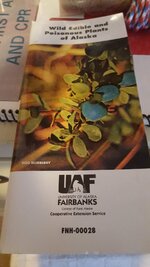Lived in the same house for over 30 years and have taken to "prepping". Those Natgeo preppers would laugh at our minimal preparations, but we do have a nice supply of freeze dryed foods and water. Yet I recently just realized that the easiest and best prep we could have done was totally and 100% overlooked.
It's always disturbed me that our little yearly garden efforts, while fun and tasty, would not come close to feeding a single starving person for a month. I'm watching the business park folks recently dig up the cattails that have been there for the 10 years to replace them with some stupid non-useful ornamentals. I've always thought they could have been an emergency food source and I realized: "instead of planting flowers, why not plant something useful in the flower beds?". A quick search and I see Camas bulbs were a critical staple in native diets. They would be close to perfect to plant not just in our flower beds, but in the environmental zone next to the park a half block away where Iris and tulips grow wild, in the business park, anywhere there is a spot of land. It would be like a self propagating food bank for when or if the SHTF. Most folks wouldn't recognize them as a food source and leave them be, and they would not need but minimal effort to spread. DOHHH! I'll be looking for additional things to plant, but for now have 50 Blue flower Camas bulbs coming from the nursery. I've seen these plants all over out there outside of town (Camas, Washington is named for them of course) but don't want to dig them up. White camas is poison and you don't know unless you see the flowers. I'm not waiting and miss the planting season this year so best to just order them. More info for anyone interested.
Native American Food: Camas | Native American Netroots
Cooking and Eating Blue Camas Bulbs
Are any of you doing something like this and if so, can you share what you've been planting or what has been working?
It's always disturbed me that our little yearly garden efforts, while fun and tasty, would not come close to feeding a single starving person for a month. I'm watching the business park folks recently dig up the cattails that have been there for the 10 years to replace them with some stupid non-useful ornamentals. I've always thought they could have been an emergency food source and I realized: "instead of planting flowers, why not plant something useful in the flower beds?". A quick search and I see Camas bulbs were a critical staple in native diets. They would be close to perfect to plant not just in our flower beds, but in the environmental zone next to the park a half block away where Iris and tulips grow wild, in the business park, anywhere there is a spot of land. It would be like a self propagating food bank for when or if the SHTF. Most folks wouldn't recognize them as a food source and leave them be, and they would not need but minimal effort to spread. DOHHH! I'll be looking for additional things to plant, but for now have 50 Blue flower Camas bulbs coming from the nursery. I've seen these plants all over out there outside of town (Camas, Washington is named for them of course) but don't want to dig them up. White camas is poison and you don't know unless you see the flowers. I'm not waiting and miss the planting season this year so best to just order them. More info for anyone interested.
Native American Food: Camas | Native American Netroots
Cooking and Eating Blue Camas Bulbs
Are any of you doing something like this and if so, can you share what you've been planting or what has been working?












